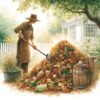Winterizing Garden Beds: A Step-by-Step Guide to Protecting Your Plants
Prepping your garden for Jack Frost
Winter is coming, and just like we cozy up indoors, our gardens too need preparation for the colder months. Properly winterizing garden beds is a crucial step in ensuring your plants come back stronger in the spring. Here’s how to give your garden the protection it needs:
1. Understand Your Zone
Before starting, familiarize yourself with your USDA hardiness zone. This will guide you on the specific needs of your region when it comes to winterizing garden beds.
2. Clean Up
Remove all the spent and decayed plants. This not only tidies up the garden but also reduces the chances of diseases and pests overwintering in the debris.
3. Prune Perennials
Trim back dead or diseased growth. For some plants, it’s best to wait until early spring to prune, so ensure you know the specific needs of your plants.
4. Add a Layer of Mulch
Apply a thick layer of organic mulch, like straw or shredded leaves, around the base of plants. This acts as an insulator, regulating soil temperature and preventing rapid freeze-thaw cycles which can be damaging.
5. Protect Tender Plants
For plants that are particularly sensitive to winter cold, consider wrapping them in burlap or using row covers. This provides an added layer of protection against harsh winds and frost.
6. Water Well Before the First Freeze
Moist soil retains heat better than dry soil. Giving your garden a good watering before the first major freeze can provide extra protection for plant roots.
7. Consider Cover Crops
Planting cover crops like clover or rye can improve soil health throughout winter. They prevent erosion, suppress weeds, and can be tilled into the soil in spring to add organic matter.
8. Store Potted Plants
If you have container gardens, consider moving them indoors or to a sheltered location. Pots can freeze faster than ground soil, putting your plants at risk.
9. Check Soil Drainage
Ensure your beds are well-draining. Waterlogged soil can lead to root rot and can be harmful when it freezes.
10. Plan for the Next Season
Winter is a great time to reflect on your garden’s performance. Make notes, plan new beds, and order seeds. Ready your garden not just for winter, but the spring to come.
Conclusion
Winterizing garden beds might seem like a daunting task, but with careful planning and a bit of effort, your garden will weather the cold months gracefully. Come spring, you’ll be rewarded with a garden ready to burst into life once more.
Prepare, protect, and prosper: let’s ensure our gardens thrive even after the harshest winters. If you found this guide useful, share it with fellow gardening enthusiasts.










